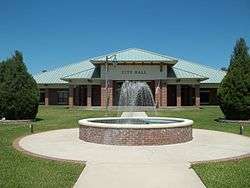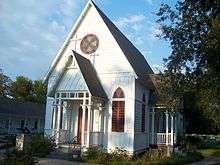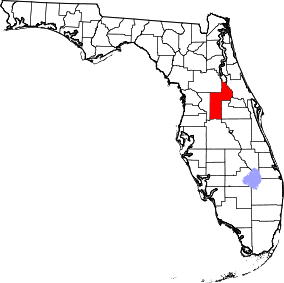Fruitland Park, Florida
| Fruitland Park, Florida | |
|---|---|
| City | |
 | |
| Motto: " The Friendly City " | |
 Location in Lake County and the state of Florida | |
| Coordinates: 28°51′31″N 81°54′47″W / 28.85861°N 81.91306°WCoordinates: 28°51′31″N 81°54′47″W / 28.85861°N 81.91306°W | |
| Country | United States of America |
| State | Florida |
| County | Lake |
| Government | |
| • Mayor | Chris Bell |
| Area | |
| • Total | 3.7 sq mi (9.5 km2) |
| • Land | 2.9 sq mi (7.6 km2) |
| • Water | 0.8 sq mi (1.9 km2) |
| Elevation | 108 ft (33 m) |
| Population (2000)[1] | |
| • Total | 3,186 |
| • Estimate (2008) | 4,293 |
| • Density | 860/sq mi (340/km2) |
| Time zone | Eastern (EST) (UTC-5) |
| • Summer (DST) | EDT (UTC-4) |
| ZIP code | 34731 |
| Area code(s) | 352 |
| FIPS code | 12-24975[2] |
| GNIS feature ID | 0282844[3] |
Fruitland Park is a city in Lake County, Florida, United States. The population was 3,186 at the 2000 census. The Census Bureau estimated the population in 2008 to be 4,293.[1] It is part of the Orlando–Kissimmee–Sanford Metropolitan Statistical Area.
Geography
Fruitland Park is located at 28°51′31″N 81°54′47″W / 28.858571°N 81.913114°W.[4]
According to the United States Census Bureau, the city has a total area of 9.5 km² (3.7 mi²). 7.6 km² (2.9 mi²) of it is land and 1.9 km² (0.8 mi²) of it (20.44%) is water.
Demographics
| Historical population | |||
|---|---|---|---|
| Census | Pop. | %± | |
| 1930 | 270 | — | |
| 1940 | 362 | 34.1% | |
| 1950 | 551 | 52.2% | |
| 1960 | 774 | 40.5% | |
| 1970 | 1,359 | 75.6% | |
| 1980 | 2,259 | 66.2% | |
| 1990 | 2,754 | 21.9% | |
| 2000 | 3,186 | 15.7% | |
| 2010 | 4,078 | 28.0% | |
| Est. 2015 | 4,483 | [5] | 9.9% |
As of the census[2] of 2000, there were 3,186 people, 1,192 households, and 890 families residing in the city. The population density was 421.3/km² (1,092.1/mi²). There were 1,288 housing units at an average density of 170.3/km² (441.5/mi²). The racial makeup of the city was 89.08% White, 7.16% African American, 0.56% Native American, 1.32% Asian, 0.06% Pacific Islander, 0.63% from other races, and 1.19% from two or more races. Hispanic or Latino of any race were 2.54% of the population.
There were 1,192 households out of which 37.2% had children under the age of 18 living with them, 56.1% were married couples living together, 14.2% had a female householder with no husband present, and 25.3% were non-families. 20.8% of all households were made up of individuals and 8.9% had someone living alone who was 65 years of age or older. The average household size was 2.67 and the average family size was 3.07.
In the city the population was spread out with 27.9% under the age of 18, 8.6% from 18 to 24, 29.2% from 25 to 44, 22.3% from 45 to 64, and 12.0% who were 65 years of age or older. The median age was 36 years. For every 100 females there were 93.2 males. For every 100 females age 18 and over, there were 88.2 males.
The median income for a household in the city was $40,403, and the median income for a family was $42,665. Males had a median income of $29,375 versus $19,951 for females. The per capita income for the city was $16,400. About 8.1% of families and 10.2% of the population were below the poverty line, including 14.0% of those under age 18 and 3.0% of those age 65 or over.
History
Fruitland Park predates the American Civil War, although the name of the town didn't come until later. It was originally called Gardenia. The earliest settler was M. Calvin Lee, of the Evander Lee family of Leesburg,[7] who planted a citrus grove. After the war, a son-in-law of the Lee family, P.S. Bouknight, homesteaded 40 acres (160,000 m2) near Mirror Lake.
In 1875 the State of Florida sent Captain Kendricks to the northern part of the US to talk about the advantages of living in Florida. Due to Major Orlando P. Rooks poor health, and already considering a move, he had his wife, Josephine, moved to Fruitland Park.[8] They built their first home on Crystal Lake in 1877. It was here that the first white child, Frederic, was born in 1882.
The Fruitland Nurseries of Augusta, Georgia, was owned by J. P. Berckmann, friend of Major Rook. Major Rook named the town Fruitland Park for the nurseries, and the main street Berckmann Street for this friend.
The postal authorities refused to recognize the name Fruitland Park as there was already a Fruitland in the State. At their request the name was changed to Gardenia in 1884. The Florida Railroad, put through the town just prior to this, had listed the town as Fruitland Park in all their printed matter and refused to recognize the new name of Gardenia. Consequently, all freight and express had to be directed to Fruitland Park and all mail addressed to Gardenia. This caused a great deal of confusion which lasted from 1884 to 1888 when a petition was sent to the postal authorities to have the name changed back to Fruitland Park. The petition was granted in 1888.
On December 20, 1884, Rev. G.W. Butler organized the first "community" church in Fruitland Park. The church had acquired to lots on College Ave., between Fountain St. and Lime St.[9] The church was built in 1886-1887. That building burned in 1934, but was rebuilt in 1935. That building was later sold to the United Pentecostal Church and still remains today.
Fruitland Park was granted a Charter by the State of Florida on May 25, 1927.[10]
Today the city boasts churches, schools, and numerous businesses. It still calls itself "Hometown USA."
Fruitland Park is also home to the oldest Dirt Kart Track in America. The 1/6 mile clay oval has hosted Saturday Night Dirt Kart Racing for Go Kart enthusiast since opening in 1956.
Expansion of The Villages
On December 10, 2013, the The Villages of Lake-Sumter Inc. closed on a deal to purchase property in Fruitland Park for $8 million from a private owner. Subsequently they also began the annexation and rezoning process with the city. The property is currently the construction site for 2,038 new Villages homes, a project with final completion projected sometime in 2016. It was determined that the city of Fruitland Park stands to earn approximately $13 million in impact fees and building permits as a result of the expansion, not including ongoing tax revenues upon completion.[11] Updated for accuracy 04/04/16 City of Fruitland Park-Executive Staff Assistance-Amanda Perez-ap
See also

References
- 1 2 "Population Estimates" (CSV). 2008 Population Estimates. United States Census Bureau. July 1, 2009. Retrieved July 24, 2009.
- 1 2 "American FactFinder". United States Census Bureau. Retrieved 2008-01-31.
- ↑ "US Board on Geographic Names". United States Geological Survey. 2007-10-25. Retrieved 2008-01-31.
- ↑ "US Gazetteer files: 2010, 2000, and 1990". United States Census Bureau. 2011-02-12. Retrieved 2011-04-23.
- ↑ "Annual Estimates of the Resident Population for Incorporated Places: April 1, 2010 to July 1, 2015". Retrieved July 2, 2016.
- ↑ "Census of Population and Housing". Census.gov. Retrieved June 4, 2015.
- ↑ Leesburg history
- ↑ Fruitland Park hiking tour
- ↑ CUMC History
- ↑ Fruitland Park history
- ↑ "Villages closes $8 million deal on Fruitland Park property". Villages-News. December 10, 2013. Retrieved April 28, 2015.
